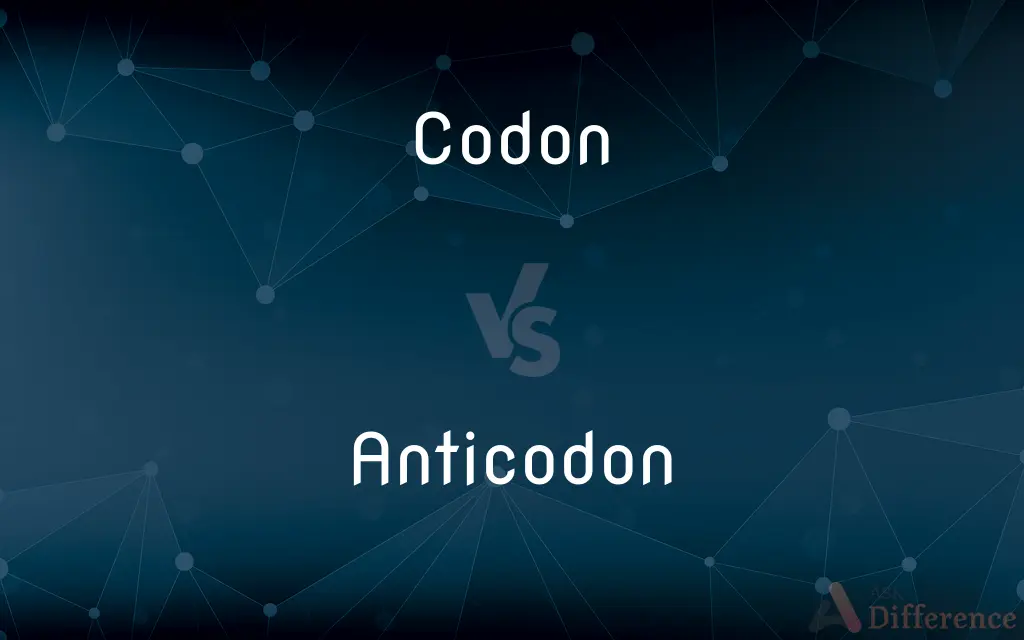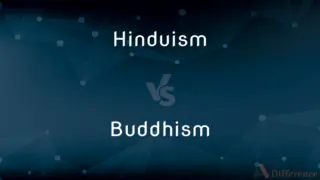Codon vs. Anticodon — What's the Difference?
By Tayyaba Rehman & Fiza Rafique — Updated on March 15, 2024
A codon is a sequence of three nucleotides in mRNA that specifies a particular amino acid or stop signal during protein synthesis, while an anticodon is a complementary sequence of three nucleotides in tRNA that pairs with a codon.

Difference Between Codon and Anticodon
Table of Contents
ADVERTISEMENT
Key Differences
Codons are essential elements in the genetic code, found within messenger RNA (mRNA). Each codon consists of three nucleotides, and it specifies either one of the twenty amino acids used in the synthesis of proteins or a stop signal, indicating the end of protein synthesis. In contrast, anticodons are found in transfer RNA (tRNA) and play a critical role in translating the mRNA's genetic information into proteins. An anticodon is a set of three nucleotides that are complementary to an mRNA codon, allowing tRNA molecules to bring the correct amino acid to the ribosome during protein synthesis.
While codons are integral to the process of transcription, where DNA is converted into mRNA, anticodons are central to translation, the next step where the sequence of mRNA is decoded to produce proteins. Codons are thus a part of the language that dictates how genetic information is expressed, whereas anticodons are part of the machinery that interprets and carries out the instructions encoded in mRNA.
The specificity of the codon-anticodon pairing is crucial for the accuracy of protein synthesis. A codon in an mRNA molecule will only pair with the anticodon of a tRNA molecule that carries the appropriate amino acid. This specificity ensures that proteins are assembled correctly according to the genetic instructions. For instance, the codon AUG not only codes for the amino acid methionine but also serves as the start signal for protein synthesis, whereas anticodons, being complementary, ensure the start of the protein assembly with the correct amino acid.
The interaction between codons and anticodons is facilitated by the ribosome, a complex molecular machine. The ribosome ensures that codons and anticodons pair correctly, enabling the tRNA to deliver the appropriate amino acid to the growing polypeptide chain. This stepwise addition of amino acids leads to the formation of a protein with a specific sequence, dictated by the sequence of codons in the mRNA.
Both codons and anticodons are fundamental to the process of gene expression, playing roles in different but interconnected stages of protein synthesis. Without the precise matching of codons and anticodons, the accurate translation of genetic information into functional proteins could not occur, highlighting the importance of both elements in the central dogma of molecular biology.
ADVERTISEMENT
Comparison Chart
Location
MRNA
TRNA
Function
Specifies amino acids or a stop signal in protein synthesis
Complementary to codon, ensures correct amino acid is added to the protein chain
Role in Protein Synthesis
Part of transcription, determining protein structure
Part of translation, interpreting mRNA's instructions
Specificity
Each codon matches a specific amino acid or stop signal
Each anticodon is complementary to a codon, ensuring correct amino acid transfer
Example
AUG codes for Methionine and acts as a start signal
UAC is the anticodon for AUG, pairing with it to start protein synthesis
Compare with Definitions
Codon
Determines the sequence of amino acids in proteins.
A series of codons in mRNA dictates the protein structure.
Anticodon
Ensures the correct amino acid is added to the polypeptide chain.
An anticodon matches its codon to add methionine to a protein.
Codon
A sequence of three nucleotides in mRNA specifying an amino acid.
The codon AUG specifies the amino acid methionine.
Anticodon
A complementary sequence of three nucleotides in tRNA.
The anticodon UAC pairs with the codon AUG.
Codon
Codes for amino acids in protein synthesis.
The codon UUU codes for the amino acid phenylalanine.
Anticodon
Involved in the translation phase of gene expression.
TRNA anticodons decode mRNA codons during protein assembly.
Codon
Can signal the start or stop of protein synthesis.
The codon AUG also serves as a start signal for protein synthesis.
Anticodon
Found in the structure of tRNA.
Each tRNA molecule has an anticodon specific to one amino acid.
Codon
Found in the genetic code of mRNA.
MRNA contains codons that are translated during protein synthesis.
Anticodon
Plays a key role in translating mRNA into protein.
Anticodons are crucial for the accuracy of protein synthesis.
Codon
A sequence of three adjacent nucleotides constituting the genetic code that determines the insertion of a specific amino acid in a polypeptide chain during protein synthesis or the signal to stop protein synthesis.
Anticodon
A sequence of three adjacent nucleotides in transfer RNA that binds to a corresponding codon in messenger RNA and designates a specific amino acid during protein synthesis.
Codon
A handbell used for summoning monks.
Anticodon
(genetics) A sequence of three nucleotides in transfer RNA that binds to the complementary triplet (codon) in messenger RNA to specify an amino acid during protein synthesis.
Codon
The "bell" or flaring mouth of a trumpet.
Codon
(biochemistry) A sequence of three adjacent nucleotides, which encode for a specific amino acid during protein synthesis or translation.
Codon
A sequence of three nucleotides in a genome or a DNA or messenger RNA molecule, which specifies the incorporation of one amino acid or is a stop signal, during the biosynthesis of proteins. Codons occur within the protein-coding segments of the DNA or RNA genome of living organisms. The amino acid sequence of proteins synthesized on ribosomes is thus determined by the sequence of the nucleotides in the genome.
Codon
A specific sequence of three adjacent bases on a strand of DNA or RNA that provides genetic code information for a particular amino acid
Common Curiosities
What role do codons and anticodons play in gene expression?
Codons determine the amino acid sequence of proteins during transcription, while anticodons ensure these instructions are accurately translated into proteins during translation.
Are codons and anticodons always complementary?
Yes, anticodons are complementary to their corresponding codons, allowing for the precise pairing necessary for protein synthesis.
How does an anticodon work?
An anticodon pairs with its complementary codon on mRNA to ensure the correct amino acid is added to the growing protein chain during translation.
What is the main function of a codon?
A codon's main function is to specify a particular amino acid or a stop signal during protein synthesis.
Can a codon pair with any anticodon?
No, a codon pairs specifically with a complementary anticodon that matches its sequence, ensuring the correct amino acid is incorporated into the protein.
Do codons only exist in mRNA?
Yes, codons are sequences of three nucleotides found exclusively in mRNA and are essential for dictating the sequence of amino acids in proteins.
What happens if a codon and anticodon do not match?
If a codon and anticodon do not match, it can lead to the incorporation of the wrong amino acid, potentially resulting in a malfunctioning protein.
How many codons are there?
There are 64 codons in the genetic code, specifying 20 amino acids and including three stop signals.
Can one amino acid be specified by more than one codon?
Yes, most amino acids are specified by more than one codon, a feature known as the redundancy of the genetic code.
Is the start codon the same in all organisms?
Yes, the start codon is the same in all living organisms.
Share Your Discovery

Previous Comparison
Educator vs. Educationist
Next Comparison
Hinduism vs. BuddhismAuthor Spotlight
Written by
Tayyaba RehmanTayyaba Rehman is a distinguished writer, currently serving as a primary contributor to askdifference.com. As a researcher in semantics and etymology, Tayyaba's passion for the complexity of languages and their distinctions has found a perfect home on the platform. Tayyaba delves into the intricacies of language, distinguishing between commonly confused words and phrases, thereby providing clarity for readers worldwide.
Co-written by
Fiza RafiqueFiza Rafique is a skilled content writer at AskDifference.com, where she meticulously refines and enhances written pieces. Drawing from her vast editorial expertise, Fiza ensures clarity, accuracy, and precision in every article. Passionate about language, she continually seeks to elevate the quality of content for readers worldwide.















































